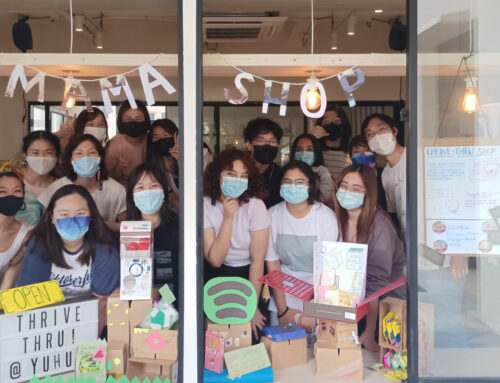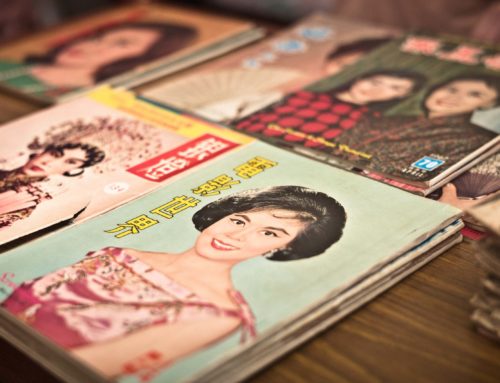Library / Field Studies
Arts and Health: An Expanding Field of Activism to Foster a Flourishing World
Library / Field Studies
Arts and Health: An Expanding Field of Activism to Foster a Flourishing World
Interview with Michael Tan
By Salty Xi Jie Ng
31 January 2023
Michael Tan’s eyes are always twinkling; quite probably, his deep sense of curiosity has shaped an illustrious trajectory from visual artist and educator making an intimate body of work about his father’s neurodegenerative disorder, to leading Arts and Health practitioner and academic. Having moved to the UK two years ago for his new position as Associate Professor in Art and Design at Lab4Living, Sheffield Hallam University, Michael has been developing novel projects in the field that take artistic practices deep into the heart of healthcare.
Arts and Health is an interdisciplinary field integrating creative practices into community and care settings, with the aim of transforming health and experiences of healthcare. In practice, it typically manifests as sessions in visual art, movement, theatre, music, and writing, while a growing body of research supports the field’s visibility and expansion. Michael recently co-published Connecting the Dots: The State of Arts and Health in Singapore, a study in an international Arts and Health journal. It identified gaps within the local Arts and Health field, including “inconsistent understanding and conceptualisation of the field as a whole across multiple stakeholders” and the “need to develop locally sensitised context-awareness”. Serving as a concise analysis of the burgeoning Arts and Health field here, Michael and his colleagues complemented the study with the creation of the Arts and Health Singapore Repository, a living archive of the field “through a listing of practice, policy, research and capacity development”.
The effect of browsing the Repository’s diverse collection of local Arts and Health efforts is an affirmation of the field’s presence and growth. Michael chats with Community Inspirations guest contributor Salty Xi Jie Ng about Arts and Health conceptually, in terms of labour, practice, and equity, as well as artistry in care and artists as carers. Elucidating the fluid nature of Arts and Health, Michael sees the potential of diverse forms of work to be independently defined, birthed from the field’s unique intersection of various sectors. This expands notions of applied creative practice alongside or outside contemporary art, positing artists as creative caregivers, with Michael an important member of this growing global and local tribe.
How did you come to the field of Arts and Health, or how did the field find you?
I stumbled upon the field of Arts and Health while working on an art intervention project in a garden for the Singapore General Hospital in 2010. I was invited by the hospital’s community relations department to work with the Parkinson outpatient support group. While searching for ideas on participatory art projects in healthcare settings, I discovered the field of Arts and Health. It felt like a treasure trove! Fascinated by its potential to foster wellbeing and diverse ways of using creativity, I noticed a stirring within —an instinctive response— that drew me towards developing the field in Singapore, as I saw how it could help create an inclusive and flourishing society here.
What do ‘art’ and ‘health’ as concepts and worlds mean to each other?
The two concepts may seem unrelated at first glance, but they share a few things. Both can be regarded as modes of sensing, responding, communicating and reacting to the environment (physical, social, and cultural) to ascertain our being, express our humanity and navigate the world. Particularly, our ability to capture our thoughts, conjure ideas, and share them, as seen in innovations towards increased life expectancy, and in the diversity of artistic practices today. These are sensibilities and capacities that we innately possess as humans. The space where the two concepts overlap and their resulting synergy might be overlooked — this is what excites me, and is perhaps where we can start unpacking the relationship between art and health.
How would you describe the practice of Arts and Health in Singapore today? How does it differ from that of other countries? And how do our values as a multicultural nation influence how we think about the intersections of art and health?
While ‘art’ and ‘health’ are terms that we are familiar with, appreciation for their synergy as a field only emerged in recent decades. This can be attributed to increased interdisciplinary interaction, cross-sectoral collaborations, initiatives and research amongst academics, artistic and cultural practitioners, as well as the health and social care profession, that helped grow evidence that creative activities and cultural engagement offer potential health and wellbeing benefits. This paved the way for the field. It is heartening to see the growing connection and familiarity with Arts and Health amongst colleagues from sectors that previously seemed disparate.
I would like to think that our cosmopolitan outlook in Singapore encourages a willingness to consider new ideas. Sometimes there is quite a bit of persuasion needed to establish collaboration, although this is also changing. Being able to rationalise, relate and articulate concepts can be helpful in facilitating connections between fields. Our personal cultural background and values create particular lenses for the ways we think and approach our practices. As a multicultural and multilingual nation, negotiating and navigating cultural diversity and nuances is a unique aspect of the way we practise. This is especially so when conducting participatory art activities with participants from different ethnicities, where English is not the common language.
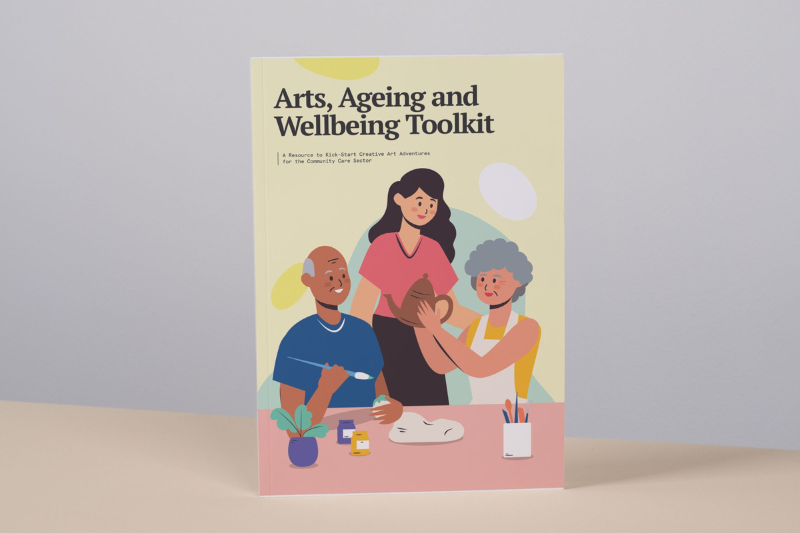
Michael developed the Arts, Ageing, and Wellbeing module for the MSc Applied Gerontology at Nanyang Technological University. This toolkit is an outcome of the module and is publicly available via the Agency for Integrated Care website here. Visual courtesy of ArtsWok.
You and your research collaborators recently set up the inaugural Arts & Health Singapore Repository to accompany the study you published. What are the Repository’s goals?
The Arts and Health Singapore Repository serves a few purposes. Firstly, it aims to account for, consolidate, and capture initial and ongoing efforts and activities that are occurring in Singapore within Arts and Health. Prior to the study on the state of Arts and Health development in Singapore (which is hosted on the repository), there lacked systematic documentation of activities and analysis of initiatives that have led to the field’s development. Secondly, it serves as a networking platform for newcomers and experienced colleagues to learn from and connect with each other, as well as contextualise Arts and Health locally in terms of its history and current efforts. We have plans to develop future events, such as seminars and workshops, to support this area. Lastly, we hope to bring visibility to ongoing efforts happening in Singapore, and particularly in Asia, which are currently underrepresented in the international arena. This supports cross-cultural dialogues, exchange and comparison of practice, policy, and research.
What are the biggest challenges and misconceptions about the field of Arts and Health globally, and in Singapore? What are you most excited about?
As a multidisciplinary field, perspectives, perceptions, and expectations may differ according to disciplinary lenses. There is also disciplinary power concerning what constitutes knowledge and the way it is produced. To me, these are some of the biggest challenges as they are linked to what we see and value as ‘evidence’. However, I think the greatest challenge is embedding the idea in public health, healthcare and social care policy while ensuring sustainability beyond the field’s early stage locally. This means an entire ecology with widespread belief in the link between creativity and health, with the allocation of public funds towards programs.
Arts and Health has various dimensions. There is a tendency, particularly for those who are less familiar with the field, to associate the practice with creative therapies. This is one of the main misconceptions. The field is expansive. The variety of work can be related to health communication, health inequalities, medical humanities, creative methods in health research, just to name a few examples beyond creative therapies.
Gestures of Care is an emerging work where I’m looking at creative movement activities to create spaces for reflection on and exploration of the non-verbal elements in care. This helps foster the perceptivity and capacities of individuals to communicate non-verbally in formal and informal settings. The aim is to transform structures that healthcare professionals have been trained in. After presenting this to colleagues in the Nursing department in Sheffield Hallam University, I’ve been asked to develop further content for nursing students.

Gestures of Care, a creative movement workshop supporting exploration of and reflections around non-verbal communication in care interaction; Lab4living, Sheffield Hallam University, 2022.
Given the Covid-19 pandemic turned a global spotlight on matters of care, how do you think Arts and Health has changed locally and globally since?
Evidently, the restrictive measures resulting from the pandemic have impacted the field significantly locally and internationally. It has affected not just the livelihood of creative practitioners but also resulted in mental health and wellbeing crises among them — although there has been more support for artists’ wellbeing, as seen in the following UK-based examples: list of resources for artists, artist peer support sessions, and a report on the wellbeing of practitioners in Arts and Health.
This globally challenging time has shown our strength and capacity as humans to innovate, in this case via new modes of interaction and access. For example, the digitisation of art events and activities has, to some extent, expanded the reach of the arts. SilverGood was an independent project here that invited artists to create content for seniors. In this way, the pandemic encouraged the growth of alternative ground-up initiatives. That said, if there is anything we can take away, it is equally important for us to be aware that digitisation does not mean equity, as there are segments of the population who do not have access to digital assets.
What is the role of care in art making today?
I believe there is a degree of care everyone exercises toward the work that they feel passionate about and are concerned with; the defining difference would be the subject. Care as a concept takes several forms: care about, caring for, caregiving, receiving care. As an artist, one may not necessarily be interested or involved in all these aspects. For example, ‘caring about’ is cognitive. It is what we give attention to and consider. It may or may not involve caring for, which is about taking action. This action might be producing a piece of work or creating a participatory project. This is perhaps the distinguishing area for me — the human-centric dimension of participatory work which could play out further as caregiving and care receiving. Through my practice, I realise participatory art-making demands care — paying attention and supporting others to flourish — the idea of artist as carer. Care also requires us to exercise a consciousness and awareness around the manner in which we interact and respond to others. This is an aspect of the work that may not be noticeable initially.
A project I’d like to bring up here is Dying Matters, an interactive, participatory performance project that began last year as a collaboration with Sheffield Hallam University theatre department colleagues and students. Talking about death often feels uncomfortable, and we’re looking at how we can encourage conversations with each other on loss and bereavement. We want to offer people space to reflect on the things they would do at an end-of-life stage and explore the complexities of talking about death.
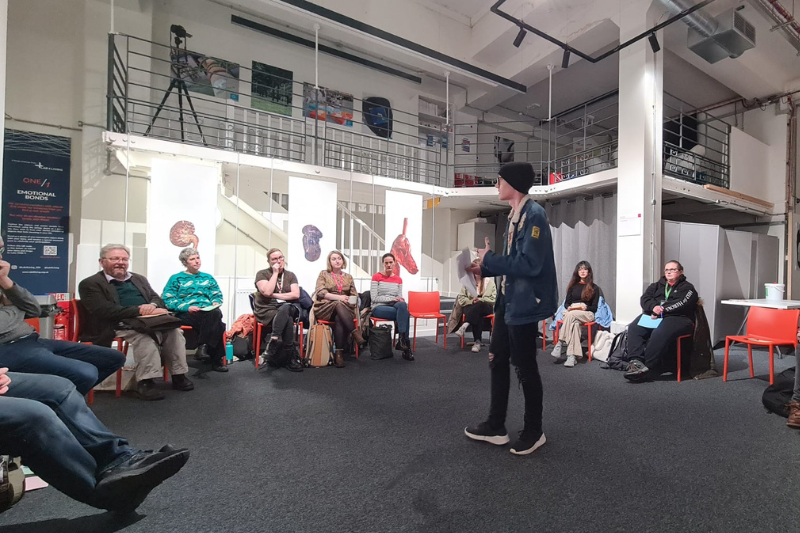
Dying Matters, a developing participatory and interactive performance with colleagues and students at Sheffield Hallam University’s Acting and Performance Programme that explores the complexities and consequences arising from struggles to talk about dying; Lab4Living, Sheffield Hallam University, 2022.
Having worked in various roles in the arts, how would you describe artistic labour in the Arts and Health field?
An aspect that I find rather unique about practice in the Arts and Health field is its human-centric nature. The work involves care labour, as the artist works on participatory projects with people who may be vulnerable or feeling disenfranchised due to their health or social circumstances. This adds demand to the work. Care requires a sense of artistry too, not in a conventional manner, but rather in terms of affect — sensing, attuning, a willingness to adjust, and a sense of knowing when to refrain, along with close communication. While the technical aspect of care (e.g. dressing a wound) can be taught, artistry involves exercising a sensibility that relates to the individual’s disposition.
As mentioned earlier, the nature of the work may not necessarily lie within the conventional art and culture sector. The creative practitioner could be a member of a research team contributing to creative research methods, or drawing on their expertise to advise on research design. Hence, artistic labour in this expansive field is not confined to specific practices, but challenges one to think about applying one’s creative and aesthetic sensibilities.
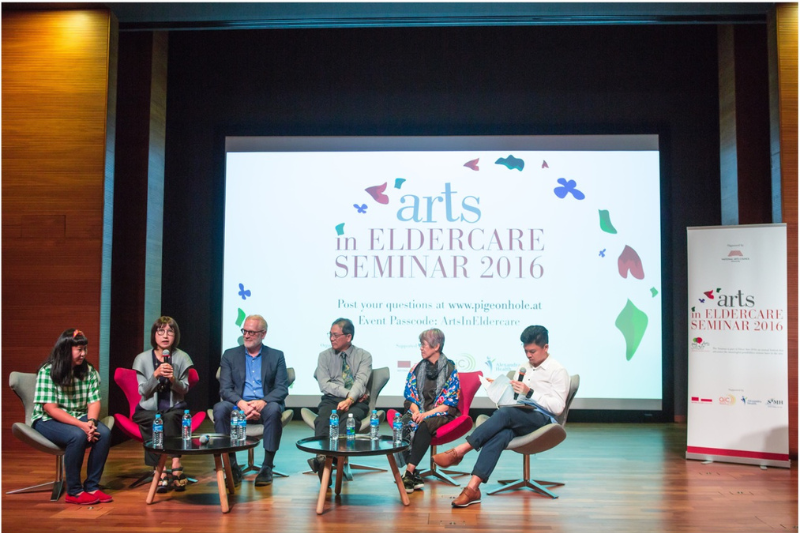
Michael (far right) moderating a panel discussion at the Arts in Eldercare Symposium at National Gallery of Singapore, 2016. Photo courtesy of National Arts Council.
Within the broad field of relational art, there are approaches that advocate for art-making in collaboration with publics, social agents and communities, that make an impact on people, society, and policy. How would you relate Arts and Health to contemporary art, and does this matter to you? Is there an alternative aesthetics in Arts and Health?
A defining feature of Arts and Health work lies in people’s interests to situate, engage, reflect, and articulate the value or anticipated contribution of the work in relation to health, wellbeing and flourishing of the self and community. There is interest in health disparities, inequalities, and inequity. It offers a way in and invites us to consider and explore our roles as creative beings in the world. It asks, Where can art occur? Who gets to experience it? What can we do? What does that encounter bring? These are the premises from which Arts and Health related work gets seeded. It offers a specific yet expansive context for one to explore, one that may not be confined to the art world.
For me, aesthetic is an affect rather than a form, format, or expectation. It exists in degrees of intensity. I wouldn’t assign a particular aesthetic to Arts and Health because that seems to assume or suggest a certain expectation on how work should look. That has been the conundrum of socially engaged art. There can be diverse ways to think and mobilise art. Trying to categorise ‘aesthetics’ seems to also exercise the hegemony of the art world. That takes away our innate capacity and agency to create things, which is exactly the challenge of the work. How can we reclaim and reconnect with our creativity? I would focus on how we can create nurturing experiences or encounters to support the emergence of aesthetics.
Given that the Arts and Health field often aims to effect change, what do you think is the relationship between activism and the Arts and Health field?
The Arts and Health field is activism. It engages us to critically think about our assumptions, perceptions and expectations about ‘art’ and ‘health’. The imagination and synergy emerging from the attention and consideration given to their overlap can disrupt, destabilise, and reconfigure organisational, disciplinary, social, sectoral, and educational structures. The destabilising and reconstituting qualities of the work excite me, as does a spirit of openness and its collaborative nature. The effect of the field is played out in varying degrees in locations where they have emerged. Efforts have led to improved services and experiences in care settings, reconsidering the role and contribution cultural organisations and creative practitioners make to foster good public health, with added implementation of national policies that recognise the contribution of the arts towards inclusive, healthy and flourishing societies. I do feel there have been several places where efforts have led to real social changes.
An example is Sparks!, a milestone partnership between Agency for Integrated Care (AIC) and National Arts Council (NAC). It was a seminal artist-in-residency programme that introduced creative activities in long term care settings to enhance the quality of residents’ lives. I curated the programme and mentored artists, which helped shape the work over time. Activities created by the artists were translated into a toolkit, which was well-disseminated by AIC to community care settings, and is also publicly available online. As another outcome of the project, the Sparks! exhibition reached people of various sectors. Overall, the project served as powerful advocacy for the role of arts in seniors’ wellbeing.
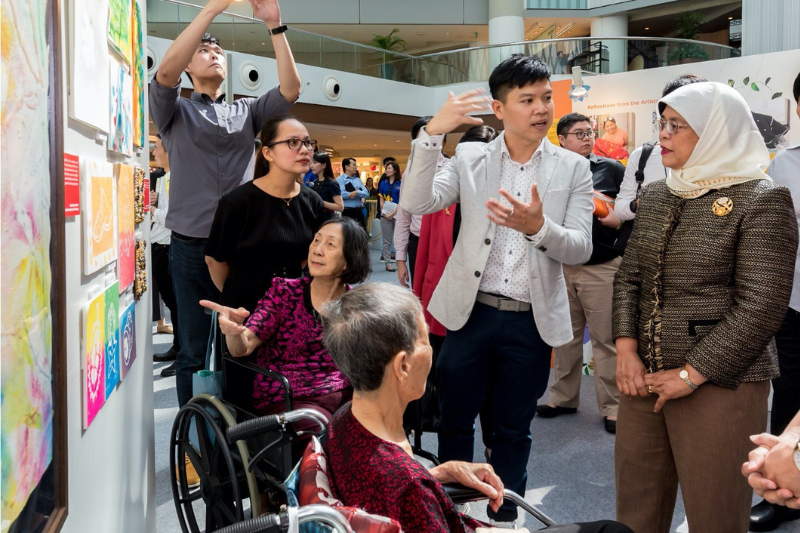
Michael served as Artist Mentor and Curator for Sparks!, the first Agency for Integrated Care-National Arts Council Artist Residency in nursing homes programme. Here he offers a tour to President of the Republic of Singapore Halimah Yacob at the opening ceremony of Sparks! Art for Wellness Exhibition, 2018. Photo courtesy of Agency for Integrated Care.
What advice would you give to a new practitioner wanting to work in Arts and Health?
As the arts and health sectors offer diverse iterations of exciting work, one might find non-typical positions within each sector to lend one’s skills and sensibilities. I have seen how skillsets in and knowledge of the art and health domains can play out in different working arenas, ranging from the health and social care context, art and cultural administration, community engagement, health research, and education, just to name a few. There are in-between, fluid spaces that are emerging for creative enablers to define, where we can see practice as research and optimise expertise to bridge different sectors. Examples of this are community engagement teams, or creative health programs in community and formal care settings.
It may be very useful for new practitioners to explore possibilities with their practice and read up on the field, its emerging trends, as well as terms and concepts, either online or by connecting with people familiar with the breadth of Arts and Health work. Overall, being able to articulate issues one is concerned with, as well as explain the value and purpose that art offers within the chosen context, will help project partners relate to and understand one’s motivations.
Learn more about Arts and Health:
Center for Arts In Medicine (USA) – What is Arts in Health?
World Health Organisation – Arts and Health
Cover image: Michael curated the Silver Arts Exhibition as part of the inaugural Silver Arts Festival organised by the National Arts Council, 2012
All images provided by Michael Tan unless specified otherwise.
About Michael Tan
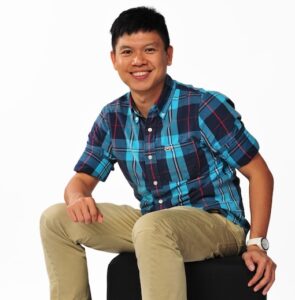
Michael is a leading advocate for arts & design for health development in Singapore. His recent publication ‘Connecting The Dots’ outlines the state of Arts and Health development in Singapore. As a creative health practitioner, researcher and educator, he has developed a growing track record of interdisciplinary creative health research collaborations and projects with colleagues within and outside of academia to transform the culture of care through creativity. He is currently an Associate Professor in Art and Design at Lab4Living at Sheffield Hallam University, UK.



